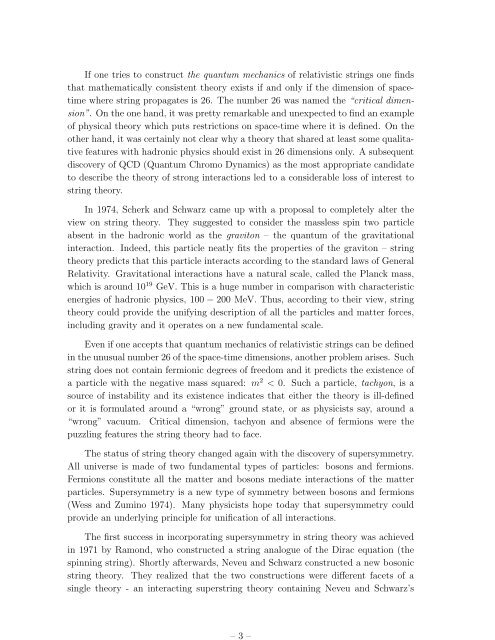Lectures on String Theory
Lectures on String Theory
Lectures on String Theory
You also want an ePaper? Increase the reach of your titles
YUMPU automatically turns print PDFs into web optimized ePapers that Google loves.
– 3 –<br />
If <strong>on</strong>e tries to c<strong>on</strong>struct the quantum mechanics of relativistic strings <strong>on</strong>e finds<br />
that mathematically c<strong>on</strong>sistent theory exists if and <strong>on</strong>ly if the dimensi<strong>on</strong> of spacetime<br />
where string propagates is 26. The number 26 was named the “critical dimensi<strong>on</strong>”.<br />
On the <strong>on</strong>e hand, it was pretty remarkable and unexpected to find an example<br />
of physical theory which puts restricti<strong>on</strong>s <strong>on</strong> space-time where it is defined. On the<br />
other hand, it was certainly not clear why a theory that shared at least some qualitative<br />
features with hadr<strong>on</strong>ic physics should exist in 26 dimensi<strong>on</strong>s <strong>on</strong>ly. A subsequent<br />
discovery of QCD (Quantum Chromo Dynamics) as the most appropriate candidate<br />
to describe the theory of str<strong>on</strong>g interacti<strong>on</strong>s led to a c<strong>on</strong>siderable loss of interest to<br />
string theory.<br />
In 1974, Scherk and Schwarz came up with a proposal to completely alter the<br />
view <strong>on</strong> string theory. They suggested to c<strong>on</strong>sider the massless spin two particle<br />
absent in the hadr<strong>on</strong>ic world as the gravit<strong>on</strong> – the quantum of the gravitati<strong>on</strong>al<br />
interacti<strong>on</strong>. Indeed, this particle neatly fits the properties of the gravit<strong>on</strong> – string<br />
theory predicts that this particle interacts according to the standard laws of General<br />
Relativity. Gravitati<strong>on</strong>al interacti<strong>on</strong>s have a natural scale, called the Planck mass,<br />
which is around 10 19 GeV. This is a huge number in comparis<strong>on</strong> with characteristic<br />
energies of hadr<strong>on</strong>ic physics, 100 − 200 MeV. Thus, according to their view, string<br />
theory could provide the unifying descripti<strong>on</strong> of all the particles and matter forces,<br />
including gravity and it operates <strong>on</strong> a new fundamental scale.<br />
Even if <strong>on</strong>e accepts that quantum mechanics of relativistic strings can be defined<br />
in the unusual number 26 of the space-time dimensi<strong>on</strong>s, another problem arises. Such<br />
string does not c<strong>on</strong>tain fermi<strong>on</strong>ic degrees of freedom and it predicts the existence of<br />
a particle with the negative mass squared: m 2 < 0. Such a particle, tachy<strong>on</strong>, is a<br />
source of instability and its existence indicates that either the theory is ill-defined<br />
or it is formulated around a “wr<strong>on</strong>g” ground state, or as physicists say, around a<br />
“wr<strong>on</strong>g” vacuum. Critical dimensi<strong>on</strong>, tachy<strong>on</strong> and absence of fermi<strong>on</strong>s were the<br />
puzzling features the string theory had to face.<br />
The status of string theory changed again with the discovery of supersymmetry.<br />
All universe is made of two fundamental types of particles: bos<strong>on</strong>s and fermi<strong>on</strong>s.<br />
Fermi<strong>on</strong>s c<strong>on</strong>stitute all the matter and bos<strong>on</strong>s mediate interacti<strong>on</strong>s of the matter<br />
particles. Supersymmetry is a new type of symmetry between bos<strong>on</strong>s and fermi<strong>on</strong>s<br />
(Wess and Zumino 1974). Many physicists hope today that supersymmetry could<br />
provide an underlying principle for unificati<strong>on</strong> of all interacti<strong>on</strong>s.<br />
The first success in incorporating supersymmetry in string theory was achieved<br />
in 1971 by Ram<strong>on</strong>d, who c<strong>on</strong>structed a string analogue of the Dirac equati<strong>on</strong> (the<br />
spinning string). Shortly afterwards, Neveu and Schwarz c<strong>on</strong>structed a new bos<strong>on</strong>ic<br />
string theory. They realized that the two c<strong>on</strong>structi<strong>on</strong>s were different facets of a<br />
single theory - an interacting superstring theory c<strong>on</strong>taining Neveu and Schwarz’s

















